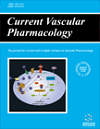- Home
- A-Z Publications
- Current Vascular Pharmacology
- Previous Issues
- Volume 5, Issue 4, 2007
Current Vascular Pharmacology - Volume 5, Issue 4, 2007
Volume 5, Issue 4, 2007
-
-
Strategies to Reduce Vascular Risk Associated with Obesity
More LessAuthors: Peter F. Bodary, Heidi B. Iglay and Daniel T. EitzmanThe obesity pandemic will likely have a significant impact on the global incidence of cardiovascular disease. Although the mechanisms linking obesity and cardiovascular disease are unclear, recent studies have implicated the adipocyte as a potentially important mediator of vascular complications. The adipocyte is no longer considered a passive storage depot for triglycerides and fatty acids, but rather an active meta Read More
-
-
-
Saving the Ischemic Penumbra: Potential Role for Statins and Phosphodiesterase Inhibitors
More LessAuthors: Fabrizio Sallustio, Marina Diomedi, Diego Centonze and Paolo StanzioneIschemic stroke is the third cause of death and the most common cause of neurological disability. A main target of treatment is the still salvageable tissue surrounding the core of infarction and called “ischemic penumbra”. Up to now the only drug approved for the treatment of acute ischemic stroke is recombinant tissue plasminogen activator to achieve early arterial recanalization and hypoxic tissue reperfusion and improve n Read More
-
-
-
Microcirculatory Endothelial Dysfunction During Endotoxemia - Insights into Pathophysiology, Pathologic Mechanisms and Clinical Relevance
More LessAuthors: Marcus Czabanka, Christoph Peter, Eike Martin and Andreas WaltherAlterations in microcirculatory permeability are a characteristic of early tissue injury. Moreover, tissue edema is an early indicator of tissue dysfunction, prior to organ failure, because tissue edema is associated with impaired gas exchange, arterial hypoxemia, and may also impair tissue oxygen distribution. As a result of increased microvascular permeability, plasma fluid is lost into the interstitial space, leading to hypovol Read More
-
-
-
Structural and Functional Alteration of Blood Vessels Caused by Cigarette Smoking: An Overview of Molecular Mechanisms
More LessAuthors: Mohammad M. Rahman and Ismail LaherSmoking is a significant independent risk factor for cardiovascular disease and is a leading cause of structural and functional alterations of the cardiovascular system. Most clinical and experimental investigations of the pathophysiology of cigarette smoking have studied the effects of smoke as a whole, while a few studies focused on specific components of cigarette smoke, e.g. nicotine and carbon monoxide, which are only 2 Read More
-
-
-
Monitoring of the Antiplatelet Drugs Effect in Patients with Coronary Artery Disease: What is the Real Clinical Impact?
More LessAuthors: Luc Christiaens and Laurent MacchiAntiplatelet therapy is used to reduce the risk of ischemic events in patients with cardiovascular disease. The balance of benefits and risks of antiplatelet drugs in coronary artery disease has been evaluated in large-scale randomised trials, however the absolute benefit for an individual patient and a specific platelet-active drug need further evaluation. Several well-conducted studies have demonstrated a substantial inter Read More
-
-
-
Vascular Pleiosynergy - Does It Really Work?
More LessCardiovascular risk increases exponentially by multiple risk factors. Similarly, by simultaneously treating these risk factors the therapeutic benefit can be multiplied. It is also relevant that some drugs exert extra benefit by acting beyond their main effect. A wide range of pleiotropic effects have been reported among lipid lowering statins and thirdgeneration calcium channel blockers. These include an increase of endothelial nitric Read More
-
-
-
Near-Infrared Spectroscopy (NIRS): A Non-Invasive In Vivo Methodology for Analysis of Brain Vascular and Metabolic Activities in Real Time in Rodents
More LessNear infrared spectroscopy (NIRS) was first used as a tool for the in vivo monitoring of tissue oxygenation in the late seventies. Today, NIRS instruments are more and more used in clinical environments since they are now easy to use, sensitive, robust, provide rapid analysis and could be complementary to other non invasive methodologies such as functional magnetic resonance imaging (fMRI) and positron emission tomo Read More
-
-
-
Closure of Patent Foramen Ovale: When and How?
More LessPercutaneous closure of a patent foramen ovale (PFO) was performed in 98 consecutive patients (mean age 52.5 ± 13 years, 61 women). Indications included recurrent transient ischaemic attack (47%), cryptogenic stroke (34%), peripheral embolism (11%), disabling migraine with aura (4%), professional scuba diving (1 pt) and severe platypneaorthodeoxia syndrome (1 pt). Each PFO was characterized by transesophage Read More
-
Volumes & issues
-
Volume 23 (2025)
-
Volume 22 (2024)
-
Volume 21 (2023)
-
Volume 20 (2022)
-
Volume 19 (2021)
-
Volume 18 (2020)
-
Volume 17 (2019)
-
Volume 16 (2018)
-
Volume 15 (2017)
-
Volume 14 (2016)
-
Volume 13 (2015)
-
Volume 12 (2014)
-
Volume 11 (2013)
-
Volume 10 (2012)
-
Volume 9 (2011)
-
Volume 8 (2010)
-
Volume 7 (2009)
-
Volume 6 (2008)
-
Volume 5 (2007)
-
Volume 4 (2006)
-
Volume 3 (2005)
-
Volume 2 (2004)
-
Volume 1 (2003)
Most Read This Month
Article
content/journals/cvp
Journal
10
5
false
en


